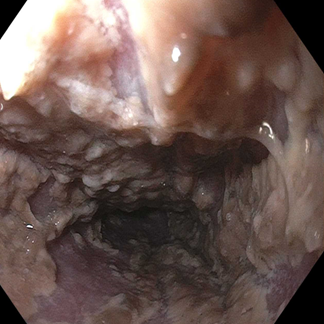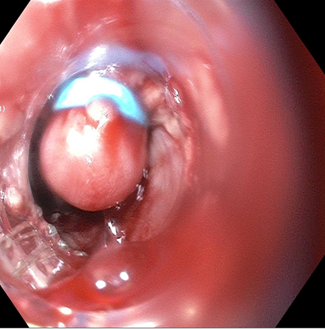Monday Poster Session
Category: GI Bleeding
P3149 - What Lies Behind Candida - Varices
Monday, October 27, 2025
10:30 AM - 4:00 PM PDT
Location: Exhibit Hall

Chimsom Orakwue, MD (she/her/hers)
NewYork-Presbyterian / Weill Cornell Medical Center
New York, NY
Presenting Author(s)
Chimsom Orakwue, MD1, Nicole Ng, MD2, Danielle Morelli, MD2, Benjamin Gordon, MD1, Daniel Paik, MD1, David Wan, MD2
1NewYork-Presbyterian / Weill Cornell Medical Center, New York, NY; 2NewYork-Presbyterian Hospital/Weill Cornell Medical Center, New York, NY
Introduction: In patients with decompensated cirrhosis, Candida esophagitis is rare. In this patient, in the setting of hematemesis and Candida, a white nipple sign was mistaken for a Candida, resulting in a surprise.
Case Description/
Methods: A 53-year-old man with alcohol use disorder, decompensated alcohol-related cirrhosis (jaundice, ascites) with Model for End-Stage Liver Disease (MELD) score of 30, and a one-month history of worsening dysphagia who was hospitalized for an expedited liver transplant evaluation. During his admission, a downtrend in his hemoglobin prompted an endoscopic evaluation. His esophagogastroduodenoscopy (EGD) showed diffuse Candida esophagitis and grade I esophageal varices. One varix had an apparent adherent white, round, plaque. While using a water jet to irrigate, the plaque dislodged resulting in active spurting from the vessel. The varix was promptly banded, and bleeding resolved. He underwent a repeat EGD (previously scheduled with his transplant screening), which showed overall improvement and post-banding esophageal ulcers. He continued his transplant pre-evaluation screening and was discharged with plans to start antifungal prophylaxis after his treatment course.
Discussion: It is rare to see Candida in a patient with cirrhosis. In this case, it led to the underappreciation of a white nipple sign, with resultant bleeding. It is unclear why Candida is rare in patients with cirrhosis, as this patient population often has immune dysregulation. This can involve impaired innate and adaptive immunity, gut barrier dysfunction, and microbial dysbiosis, which increase susceptibility to infections, including fungal infections. Fungal infections like Candida are associated with increased risk of conversion to acute on chronic liver failure and can increase mortality rates in hospitalized cirrhotic patients. Esophageal candidiasis in fact can predispose patients with cirrhosis to invasive candida infections.
In this case, it is important to recognize that patients with cirrhosis can have Candida but proceed with caution when irrigating any lesion that may be a white nipple sign.

Figure: Upon Entry, Upper Esophagus, Pre-Banding

Figure: Upon Withdrawal, Upper Esophagus, Post-Banding x1
Disclosures:
Chimsom Orakwue indicated no relevant financial relationships.
Nicole Ng indicated no relevant financial relationships.
Danielle Morelli indicated no relevant financial relationships.
Benjamin Gordon indicated no relevant financial relationships.
Daniel Paik indicated no relevant financial relationships.
David Wan: Medtronic – Data Monitoring Committee.
Chimsom Orakwue, MD1, Nicole Ng, MD2, Danielle Morelli, MD2, Benjamin Gordon, MD1, Daniel Paik, MD1, David Wan, MD2. P3149 - What Lies Behind Candida - Varices, ACG 2025 Annual Scientific Meeting Abstracts. Phoenix, AZ: American College of Gastroenterology.
1NewYork-Presbyterian / Weill Cornell Medical Center, New York, NY; 2NewYork-Presbyterian Hospital/Weill Cornell Medical Center, New York, NY
Introduction: In patients with decompensated cirrhosis, Candida esophagitis is rare. In this patient, in the setting of hematemesis and Candida, a white nipple sign was mistaken for a Candida, resulting in a surprise.
Case Description/
Methods: A 53-year-old man with alcohol use disorder, decompensated alcohol-related cirrhosis (jaundice, ascites) with Model for End-Stage Liver Disease (MELD) score of 30, and a one-month history of worsening dysphagia who was hospitalized for an expedited liver transplant evaluation. During his admission, a downtrend in his hemoglobin prompted an endoscopic evaluation. His esophagogastroduodenoscopy (EGD) showed diffuse Candida esophagitis and grade I esophageal varices. One varix had an apparent adherent white, round, plaque. While using a water jet to irrigate, the plaque dislodged resulting in active spurting from the vessel. The varix was promptly banded, and bleeding resolved. He underwent a repeat EGD (previously scheduled with his transplant screening), which showed overall improvement and post-banding esophageal ulcers. He continued his transplant pre-evaluation screening and was discharged with plans to start antifungal prophylaxis after his treatment course.
Discussion: It is rare to see Candida in a patient with cirrhosis. In this case, it led to the underappreciation of a white nipple sign, with resultant bleeding. It is unclear why Candida is rare in patients with cirrhosis, as this patient population often has immune dysregulation. This can involve impaired innate and adaptive immunity, gut barrier dysfunction, and microbial dysbiosis, which increase susceptibility to infections, including fungal infections. Fungal infections like Candida are associated with increased risk of conversion to acute on chronic liver failure and can increase mortality rates in hospitalized cirrhotic patients. Esophageal candidiasis in fact can predispose patients with cirrhosis to invasive candida infections.
In this case, it is important to recognize that patients with cirrhosis can have Candida but proceed with caution when irrigating any lesion that may be a white nipple sign.

Figure: Upon Entry, Upper Esophagus, Pre-Banding

Figure: Upon Withdrawal, Upper Esophagus, Post-Banding x1
Disclosures:
Chimsom Orakwue indicated no relevant financial relationships.
Nicole Ng indicated no relevant financial relationships.
Danielle Morelli indicated no relevant financial relationships.
Benjamin Gordon indicated no relevant financial relationships.
Daniel Paik indicated no relevant financial relationships.
David Wan: Medtronic – Data Monitoring Committee.
Chimsom Orakwue, MD1, Nicole Ng, MD2, Danielle Morelli, MD2, Benjamin Gordon, MD1, Daniel Paik, MD1, David Wan, MD2. P3149 - What Lies Behind Candida - Varices, ACG 2025 Annual Scientific Meeting Abstracts. Phoenix, AZ: American College of Gastroenterology.
